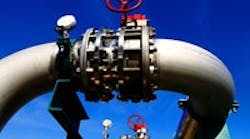Many engineers reject low-level heat from process operations because they can't find suitable heat sinks to effectively utilize the recovered heat. It's not uncommon for plants to reject either the excess heat directly or vent the low-pressure steam generated from the waste heat. So, plants with excess low-level heat rejection should find the success story of a new technology implemented by a natural gas pipeline company, in collaboration with three partners, an eye opener for recovering wasted energy.
[pullquote]
Kinder Morgan owns the 436-mile Trailblazer natural gas pipeline that winds through parts of Wyoming, Colorado and Nebraska. Booster compressor stations located at appropriate intervals maintain gas pressure as it travels along the pipeline. These compressor stations are often run by turbines, which exhaust waste heat during the compression process. There's no steam demand, as these stations require only a small amount of electricity for instrument control panels, lighting and minor needs that are usually supplied by the local utility company.
Because Kinder Morgan alone couldn't find suitable utilization opportunities, it looked for partners to help save the wasted energy. A few years ago, the company implemented a project in collaboration with the local utility company, Highline Electric Association, and M/s. Ormat Corporation, a vendor specializing in Organic Rankine Cycle (ORC) power generation modules. The generated electricity from the ORC plant is upgraded to higher voltage and fed to the utility grid.
One of the company's compressor stations has two 14,500-hp gas turbines with exhaust temperatures of 900°F. Ormat added its ORC technology to capture and turn the heat into electricity. A heat exchanger in new exhaust stacks recovers the heat from the turbines. The heat is then transferred to a working fluid of pentane in a second heat exchanger, or "vaporizer." Heating the working fluid vaporizes and expands it, causing it to drive another turbine generator. After the fluid has passed through the turbine, it's air-cooled and condensed back to a liquid. No water or additional fuel is used and there are no emissions in the heat recovery process. The 12.47-kV electric output is transformed and interconnected to a new 69-kV transmission line. While the generator could have been interconnected to an existing 12.47-kV 3-phase distribution line, the area's occasional summer lightning storms made a 69-kV line a higher reliability choice.
This project was a result of a successful collaboration between four organizations:
Partner 1: Ormat built, owns and operates the system.
Partner 2: Highline Electric Association buys the electric output of the system and uses it to meet a 10%-by-2020 standard required by the state of Colorado.
Partner 3: Tri-State, the generation and transmission provider for Highline and 43 other rural electric co-ops, supported the project through its Member Local Renewable Project program that provides financial assistance for local clean energy projects.
Partner 4: Kinder Morgan owns the natural gas pipeline and compressor station; Ormat pays the company for use of its waste heat.
All four partners consider the project successful and recommend this application to other pipelines and process plants that reject excess heat to atmosphere. At present, ORC modules with capacity as low as 100 kW are commercially available.
Not all such process plants have sufficient waste heat recovery and utilization capabilities. I have come across a chemical plant with a sulfuric acid manufacturing unit in coastal Alabama that generated about 15,000 lb/hr of excess steam. A good portion of the excess steam was exported to a neighboring plant. When the neighboring plant closed a few years ago, steam was vented continuously as it couldn't be utilized within the plant. In this plant, not only is heat energy wasted, but also good quality boiler feed water.
Low natural gas prices and the higher investment costs of ORC units could be an initial challenge. Once natural gas demand increases, availability of low-cost natural gas may disappear. Chemical processing plants should consider collaborating with partners to recover and utilize the wasted heat to reduce emissions and remain profitable.

VEN V. VENKATESAN is Chemical Processing's Energy Columnist. You can e-mail him at [email protected]
Latest from Energy Efficiency
Latest from Energy Efficiency


